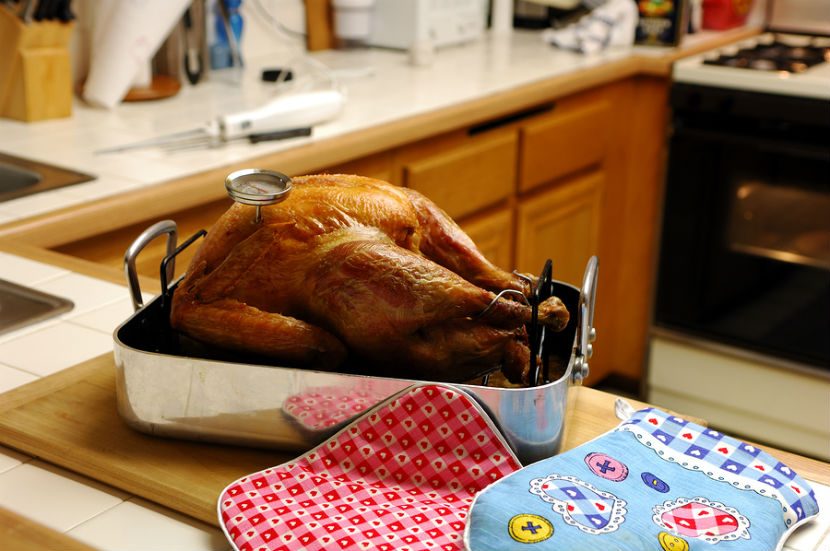
A food thermometer is an essential tool to have in the kitchen. A thermometer can tell you when your food is at its juiciest and tastiest so that you don’t overcook it. But more importantly, a food thermometer will tell you when your dish is cooked to the right temperature so that it is safe to eat. Read on to learn more about food thermometers.
Why use a food thermometer?
You’ve probably heard that hamburgers are ready when their juices run clear and that chicken is done when it’s not pink inside. Well, those guidelines can sometimes be hard to judge. The best way to know if your food is ready is to use a food thermometer. Only when your food has reached a certain temperature can you know for sure that harmful bacteria have been killed.
Even if a food looks ready on the surface, the inside may not be cooked all the way through. Once you insert a food thermometer, you can measure the internal temperature of the food. This is especially important for big dishes like a whole turkey or chicken, when you want to be sure that the heat of the oven has cooked all the way to the centre of the food.
Shopping for a food thermometer
The best thermometers are those that give you the temperature instantly and to the exact number (avoid ones that provide a doneness range). Choose an instant-read digital thermometer for the easiest and fastest results. You can find food thermometers at your local grocery store, hardware shop or kitchen/restaurant supply store.
You do not need to spend a lot of money to get a reliable and accurate thermometer. Prices may depend on the features and how easy it is to use. Whatever kind you choose to purchase, know that a thermometer is an investment in your family’s safety.
Types of food thermometers
There are many different types of thermometers that you can use depending on the food you are cooking. Use this chart to help you decide which thermometers you may need for your kitchen.
|
Digital instant/rapid-read
(This is your best choice if you can only have one thermometer)
|
Good for all foods
Works on thick and thin pieces of meat or poultry
Some come with a cable attachment* so you can check the temperature while the food is cooking in the oven.
|
|
Oven-proof (stays in the meat while it cooks)
|
Best for whole turkey, roasts, casseroles and meatloaves.
Do not use for thin foods (hamburgers, steak, chicken pieces)
|
|
Dial (not digital)
|
Use in roasts only
|
|
Fork thermometer (shows exact temperature reading)
|
Good for all foods
|
|
Fork indicator (shows doneness range)
|
Best for large cuts of meat or poultry
|
|
Colour-changing temperature indicator
|
Indicators are specific to each food (so you can buy an indicator that is just for chicken)
Best for thin foods (hamburgers, steak, chops, chicken pieces)
|
|
Pop-Up Indicators
|
Best for roasts, whole chicken, whole turkey
Indicators are specific to each food
|
*Thermometers with a cable attachment can be useful tools. The temperature probe can remain in the dish while the thermometer on the other end of the cable remains outside the oven. You can monitor the food’s temperature without having to frequently open and close the door, which may affect the oven temperature and the quality of the food.
When and where to test food temperature
|
Food
|
When
|
Where
|
|
Whole Chicken
|
Near end of cooking
Remove from heat before testing
|
Thickest part of breast pointing in the direction of the drumstick
If the bird is stuffed, also check the centre of stuffing*
|
|
Whole Turkey
|
If using digital or fork thermometer, near the end of cooking after removing from heat
If using oven proof thermometer, insert before cooking and monitor near the end of cooking
|
Insert into thickest part of inner thigh meat but do not touch the bone.
If the bird is stuffed, also check centre of stuffing*
|
|
Meatloaf, roast, casseroles, egg dishes
|
Near end of cooking
|
Thickest part of the dish
Avoid touching the bottom of the pan
|
|
Hamburgers, steaks, chops, chicken pieces
|
Near end of cooking
Remove from heat before testing
|
Thickest part of the food
Sideways into hamburger patties
|
* It is recommended that the stuffing be cooked separately from the bird for food safety reasons.
Food temperature chart
Keep a temperature chart handy in your kitchen so you always know at what temperature your food is fully cooked. This chart gives the safe cooking temperatures for ground meat, beef, poultry, pork and other foods.
Food temperature tips
-
Check the temperature of thin foods (like hamburgers) 1 minute after removing from heat and for thick foods (like roasts) 5-10 minutes after removing from heat.
-
Leave thermometer in for 30 seconds before reading the temperature.
-
For foods with irregular shapes or where some parts take longer to cook than others, check the temperature in a few different places.
-
Always wash the thermometer in hot, soapy water after each use – and especially after you’ve checked partially cooked food and then are checking again.
-
Read the manufacturer’s instructions before using your thermometer.
For more information:
Food Thermometer Food Safety Tips, Canadian Food Inspection Agency
Last Update – June 29, 2020